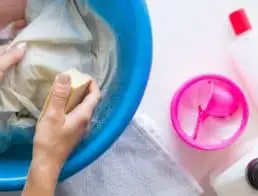An unwelcome guest, mice in the home can literally keep you up at night with their scurrying and their chewing. Not to mention the potential diseases and bacteria they bring in with them. Follow these 8 steps to get rid of mice in the house.
Step 1: Inspect Your Home
The first step in dealing with a mouse infestation is to inspect your home. This way, you’ll know exactly where these pesky little critters are hiding, and where to treat. While mice tend to hide, you’re likely to see them scurrying across the floor right in front of you.
Signs of mice in the home include: tiny footprints in the dust around your home, mouse droppings, chew marks in clothing or furniture, small holes along the wall, foul smells, scratching noises in the wall, and chew marks on food.
Use your flashlight to search along walls, floors, and anywhere you have seen droppings, chew marks, or holes, or have heard scratching sounds.
Warning: It’s important to wear protective gear when you’re inspecting your home for mice, due to the bacteria and harmful diseases they can carry. Protective clothing, eye protection, and a face mask can all help to keep you safe.
Helpful Tip: Mice are nocturnal, so you’ll have better luck performing your inspection at night when they are most active.
Keep in Mind: Even if you only see one or two mice in your home, you need to deal with the problem as soon as possible, as mice can quickly breed and grow their population.

Step 2: Choose the Best Trap
Once you’ve identified where the mice are in your home, it’s time to choose a trap for them. There are a few different kinds of traps, depending if you want to ensure the mice are gone for good, or you’d rather remove them from the home unharmed.
Classic snap traps and modern electronic traps ensure the mouse won’t return to your home. Electronic traps feature an indicator light so you know when one has been caught, and can be reused. It’s easy to see when a snap trap has done the job, and you can either reuse or dispose of it after a catch. Live mouse traps catch mice unharmed so that you can release them far from your home.
Keep in Mind: Snap traps are the least expensive trap option, but they can be gruesome to empty or get rid of. Electronic traps and live traps are slightly more expensive, but easier for squeamish homeowners to stomach.
Warning: Watch your fingers when setting snap traps, so the mechanism doesn’t activate on you.
Step 3: Pick Your Bait
Pop culture loves to show mice showing down on a snack of cheese, with good reason. Mice are strongly attracted to high-calorie foods (though not cheese). For this reason, things such as peanut butter, hazelnut spread, and chocolate all work as bait. You can also try using any food that mice have been feeding on in your house as bait, since they’re already seeking it out.
Helpful Tip: Bait doesn’t have to just be food! Materials such as cotton balls, dental floss, yarn, and twine also work, especially during winter months when mice are building their nests.
Warning: Mouse poison might be a popular pick for getting rid of mice in the house, but it is toxic for children and pets.
Step 4: Lay the Traps
Once the traps are baited, it’s time to lay them in the right spot. Pest control experts recommend setting mouse traps at right angles to walls, with the bait and trigger side closest to the wall. Good places to lay mouse traps include along walls where you’ve noticed activity, inside cabinets and closets, in the drawer below your oven, and beneath or behind appliances and furniture.
Helpful Tip: Wear gloves when setting and placing your traps in order to prevent the mice from smelling your scent, which will only cause them to avoid the trap.
Step 5: Check and Reset
Check your traps each and every morning for any casualties, and reset those that were successful.
Keep in Mind: Traps are most likely to be successful on the first night they’re set out, so try to set as many traps as possible in order to capture as many mice as possible.
Helpful Tip: Continue setting and checking your traps for at least a week after catching the last mouse in order to ensure you’ve removed the entire population.
Step 6: Seal Any Entryways
If there are any small holes or cracks in the home where mice can enter, make sure they are sealed. Products such as spray foam, as well as wood, metal, or plastic, can all help to seal any spots mice might be finding their way into your home.
Step 7: Lay Rodent Repellent
Once you’ve gotten rid of the mice in your home, you want to prevent them from coming back in. A rodent repellent applied around the perimeter of the home can help keep mice away, with both chemical-based and natural, non-chemical options available.
Keep in Mind: Always follow the manufacturer’s directions for applying rodent repellent, and be sure to use the proper safety equipment when appropriate.
Step 8: Call in the Professionals
If after following these steps you still find yourself with unwelcome houseguests, enlist the help of a professional exterminator who can help you get rid of the mice in the house.
Finding mice in your home is not a pleasant experience, but with these 8 simple steps, you can have your home free and clear of mice quickly and easily.








